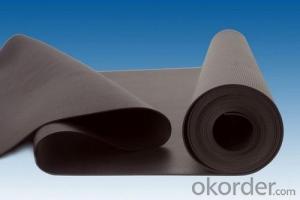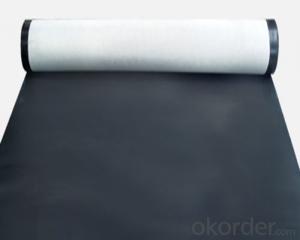EPDM Waterproofing Membrane for Underlayment
- Loading Port:
- China main port
- Payment Terms:
- TT OR LC
- Min Order Qty:
- 5000 m²
- Supply Capability:
- 100000 m²/month
OKorder Service Pledge
OKorder Financial Service
You Might Also Like
Introduction for EPDM Waterproofing Membrane:
ITEM | STANDARO REQUEST | |
Tensile strength at breaking,normal temperature,Mpa | ≥7.5 | |
Elongation at breaking, % | ≥450 | |
Tearing strength,KN/m | ≥25 | |
Bending at low temperature | ≤-40°C | |
Water impermeability,0.1Mpa×30min | Impermeability | |
Hot air aging 80°C×168h | Unchanging of tensile strength at breaking,% | ≥80 |
Unchanging of elongation at breaking,% | ≥70 | |
Appearance of 100% elongation | No crack | |
Property of anti alkali 10% Ca(OH)2×168h normal temperature | ≥80 | |
≥80 | ||
Characteristic of EPDM Waterproofing Membrane:
1>Excellent anti-aging performance, service life up to 50 years
2>Working well with in -40°C to 100°C,it can be constructed with a single layer in ambient temperature. 3>Waterproofing on various kinds of underground project,industrial of civil buildings and structures. 4>high extension rate, high tensile strength, small size changes at heat treatment
5>Good plant roots penetrability resistance and can be made waterproofing layer of planting roof
6>Special modified molecular structure ,effectively resolving the current domestic and foreign glue joint problem . 7>Good low temperature flexibility, and good performance of adapting to ambient temperature changes. 8>Convenient application ,solid joint, no environment pollution
9>chemical corrosion Resistance, can be used for special occasions
Usesage of EPDM Waterproofing Membrane:
Widely used in roofs, basement, toilet ,swimming pool, and all kinds of industry and civil building waterproofing, reservoir, bridge, underground, tunnel and dam waterproofing ,especially to the keystone waterproofing projects which is durability, high corrosion resistance and easy deformation
FAQ of Waterproofing Membrane
a.Can we get some samples before place order?
Answer: We can send the free samples to you by freight collect.
b.How many years can your PVC membrane guarantee?
Answer: We will guarantee the quality for 5 years at least.
c.Which countries you ever export the product?
Answer: We export the PVC membrane to South Africa, Middle east and even European countries.

- Q: It is good for black roof with waterproof paper
- SBS surface is divided into: PE film, no film, Liao film, sand surface, shale surface and other categories. The blacks mentioned in the problem belong to PE film and no film, and the silver is the membrane of the membrane. There is no difference between the use of good or bad comparability.
- Q: Can a waterproofing membrane be installed in wet conditions?
- Yes, a waterproofing membrane can be installed in wet conditions. However, it is important to ensure that the surface being waterproofed is dry and free of any standing water before the installation. This is because the membrane needs a clean and dry surface to adhere properly and create an effective barrier against water. If the surface is wet, it may prevent the membrane from bonding correctly, leading to potential leaks or failures in the waterproofing system. Therefore, it is recommended to wait for the surface to dry or use appropriate methods to remove any excess moisture before installing the waterproofing membrane.
- Q: Can a waterproofing membrane be used for loading docks and warehouses?
- Yes, a waterproofing membrane can be used for loading docks and warehouses. Waterproofing membranes are commonly used in these areas to prevent water infiltration and protect the building's structure and contents from moisture damage. They create a watertight barrier that helps to maintain a dry and safe environment for the storage and movement of goods.
- Q: Can a waterproofing membrane be used for a rooftop garden protection?
- Yes, a waterproofing membrane can be used for rooftop garden protection. A waterproofing membrane is designed to prevent water from seeping through the roof, which makes it an ideal choice for protecting a rooftop garden. It creates a barrier that keeps water out, preventing any potential damage to the structure of the rooftop or the plants in the garden. In addition to providing waterproofing, some membranes also offer other benefits such as UV resistance and root resistance, which further enhance their suitability for rooftop garden protection.
- Q: Can a waterproofing membrane be used on tunnels with railway systems?
- Yes, a waterproofing membrane can be used on tunnels with railway systems. The membrane helps to prevent water ingress and moisture damage to the tunnel structure, ensuring the safety and longevity of the railway system.
- Q: Can a waterproofing membrane be covered or concealed by other finishes or materials?
- Yes, a waterproofing membrane can be covered or concealed by other finishes or materials. In fact, it is common practice to do so in construction projects. The purpose of a waterproofing membrane is to provide a barrier against water infiltration and protect the underlying structure. It is typically installed on surfaces such as roofs, foundations, or walls before other finishes or materials are applied. Covering the waterproofing membrane with other finishes or materials serves two main purposes. Firstly, it helps to enhance the aesthetics of the structure. Whether it is a roof, a bathroom, or a basement, concealing the waterproofing membrane allows for the installation of more visually appealing finishes like tiles, paints, or decorative elements. Secondly, covering the waterproofing membrane also provides an additional layer of protection. While the membrane itself is designed to be resistant to water, it can still be susceptible to damage from UV rays, foot traffic, or general wear and tear. By adding other finishes or materials on top, such as protective coatings, tiles, or concrete, the waterproofing membrane is shielded from potential damage, prolonging its lifespan and effectiveness. However, it is important to note that proper installation and compatibility between the waterproofing membrane and the covering materials are crucial. The covering materials should not compromise the integrity of the membrane or create any points of weakness. Additionally, any penetrations or joints in the covering materials must be meticulously sealed to maintain the waterproofing system's effectiveness. Therefore, while a waterproofing membrane can be covered or concealed by other finishes or materials, it is essential to follow manufacturer guidelines and consult with professionals to ensure that the overall waterproofing system remains intact and performs as intended.
- Q: Can a waterproofing membrane be used on masonry surfaces?
- Yes, a waterproofing membrane can be used on masonry surfaces. It is a common practice to apply waterproofing membranes on masonry surfaces to prevent water penetration and protect the structure from moisture damage.
- Q: Are there any specific considerations for installing a waterproofing membrane on wood surfaces?
- Yes, there are several specific considerations for installing a waterproofing membrane on wood surfaces. Firstly, it is important to ensure that the wood surface is clean, dry, and free from any debris or loose material. This will help in achieving a proper adhesion of the waterproofing membrane. Additionally, it is crucial to choose a membrane specifically designed for wood surfaces, as they may require additional flexibility and resistance to expansion and contraction. It is also recommended to apply a primer or sealer to the wood surface before installing the membrane to improve its adhesion and longevity. Lastly, regular inspection and maintenance of the waterproofing membrane is essential to identify any potential issues and ensure its effectiveness over time.
- Q: Can waterproofing membranes be used on stormwater management systems?
- Yes, waterproofing membranes can be used on stormwater management systems. Waterproofing membranes are commonly used to prevent water infiltration and protect structures from water damage. In the case of stormwater management systems, which are designed to capture, store, and manage rainwater runoff, waterproofing membranes can be used to create a watertight seal and prevent leaks or seepage. Stormwater management systems often include components such as retention ponds, infiltration basins, or underground storage systems. These components need to be properly sealed to ensure that the collected stormwater is contained and managed effectively. Waterproofing membranes, when installed correctly, can provide an impermeable barrier that prevents water from escaping or infiltrating the system. Using waterproofing membranes on stormwater management systems offers several benefits. Firstly, it helps to maintain the integrity and functionality of the system by preventing leaks or seepage that may compromise its performance. This ensures that the stormwater is effectively captured and managed, reducing the risk of flooding or erosion. Additionally, waterproofing membranes can extend the lifespan of stormwater management systems by protecting them from water damage. Water infiltration can lead to structural deterioration, corrosion, or the growth of mold and mildew, which can all weaken the system over time. By creating a waterproof barrier, the membranes help to preserve the structural integrity of the components, increasing their longevity and reducing maintenance requirements. Furthermore, using waterproofing membranes on stormwater management systems can also contribute to environmental sustainability. By effectively containing and managing stormwater runoff, these systems help to reduce water pollution and improve the quality of natural water bodies. Waterproofing membranes play a crucial role in preventing stormwater from carrying pollutants, such as chemicals or sediment, into rivers, lakes, or oceans. In summary, waterproofing membranes can be used on stormwater management systems to create a watertight seal, prevent leaks, and protect the components from water damage. By providing an impermeable barrier, these membranes help to maintain the functionality and integrity of the system, extend its lifespan, and contribute to environmental sustainability by reducing water pollution.
- Q: Can a waterproofing membrane be used in crawl spaces?
- Yes, a waterproofing membrane can be used in crawl spaces. Crawl spaces are vulnerable to moisture and water intrusion, which can lead to issues such as mold, mildew, and structural damage. Using a waterproofing membrane can help protect the crawl space from water damage by creating a barrier against moisture. The membrane is typically installed on the walls and floor of the crawl space, effectively sealing it off from water and preventing water from seeping in. This can be especially beneficial in areas with high water table levels or frequent flooding. Additionally, the waterproofing membrane can also help to improve indoor air quality by preventing the growth of mold and reducing the presence of allergens. It is important to consult with a professional to determine the most suitable waterproofing membrane and installation method for a specific crawl space, as different crawl spaces may have varying requirements.
Send your message to us
EPDM Waterproofing Membrane for Underlayment
- Loading Port:
- China main port
- Payment Terms:
- TT OR LC
- Min Order Qty:
- 5000 m²
- Supply Capability:
- 100000 m²/month
OKorder Service Pledge
OKorder Financial Service
Similar products
Hot products
Hot Searches
Related keywords
























